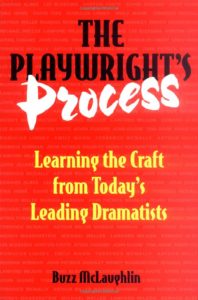
The Playwright’s Process:
Learning the Craft from Today’s Leading Dramatists
Here is the first and only manual for playwrights ever designed to draw directly from the wisdom of leading contemporary dramatists. Interwoven with hundreds of quotations from the author’s own in-depth interview series at the Dramatists Guild, in New York City, The Playwright’s Process offers a fresh and lively discussion of the indispensable ingredients of strong dramatic writing. Every essential step the writer must take to create a well-written, stageworthy play is examined and explored.
Currently I’m working on a new book titled A Writer Prepares: The Process of Story Development, designed for screenwriters, playwrights, and all writers of fiction. Here’s an excerpt from the Introduction:
When and where does the writing of a play, screenplay, teleplay, novel or any piece of fiction really begin? In my experience as a writer myself, a teacher of writing and as a professional script consultant for over four decades, when I pose that question it most often produces looks of puzzlement from both beginning students and established writers and everyone in between. Why? Because the answer seems like a no-brainer—obviously it’s when you start writing Act 1, scene I, or first put down the words “Fade In,” or capture your first sentence of your novel or short story on page one.
But, in fact, that isn’t the answer.
The right answer to this question forms the basis of this book. Any fiction writing, from plays to screenplays and teleplays to novels to short stories, really begins long before you find yourself staring at that first blank page of your working draft. It begins when that new idea first floats into your head and for some unknown reason you grab hold of it and start turning it over in your mind. It begins at that moment even though it might be filed away and sit quietly percolating in some quiet corner of your brain for a good length of time. But a seed has been planted. A possible story idea has been captured. And with the right timing and the application of a carefully arranged development process, that seed of an idea can be made to germinate and begin to take on an exciting life of its own—all long before you put down that first word on page one of your initial draft.
One way to look at this is to visualize your finished manuscript as the tip of an iceberg—that section of the whole that floats above the surface, while the other nine-tenths lies hidden and submerged. Cliché as this reference may be, it’s an accurate image of what makes a good story lift off the page and have lasting impact on your readers or audience. In other words, the actual pages of draft you produce must be supported and held up by a great deal of subtextual mass that’s hidden from view but is very real and present all the same. And it’s this simple truth that separates good storytelling from bad and is the key to writing rich and unforgettable tales that keep your readers transfixed from the first page to the last.
This book lays out a process of discovery, an approach to pre-draft story development work that thoroughly explores your story idea, the characters that will populate that story, and the emerging structural shape of your tale that those characters will guide you to. It’s a step by step approach to uncovering and examining closely the nine-tenths under the surface that will lift your story off the page and into the hearts and minds of your readers. And, given the title of the book, there’s no hiding the fact that in one sense it’s an effort to present the writer’s version of Constantin Stanislavski’s famous text An Actor Prepares, in which the process of developing a role at the world-renowned Moscow Art Theatre is thoroughly examined and dissected.
When the book is ready to purchase, I’ll put a link here so you can check it out.

Broadway and Hollywood: A History of Economic Interaction
Arno Press, A Subsidiary of the New York Times, New York, 1974
My PhD dissertation made it into hardcover, which still can be found available for purchase at places like Abe Books, although the prices are a bit exorbitant!
